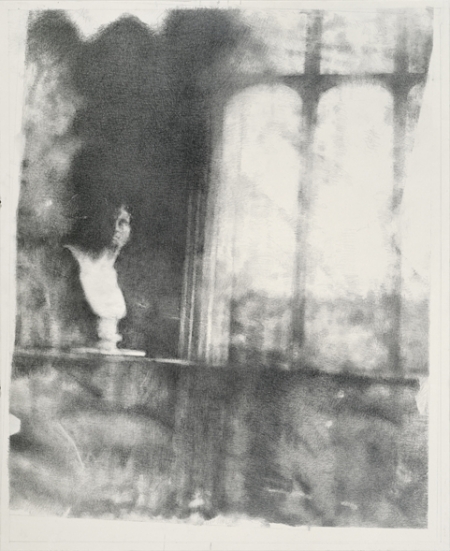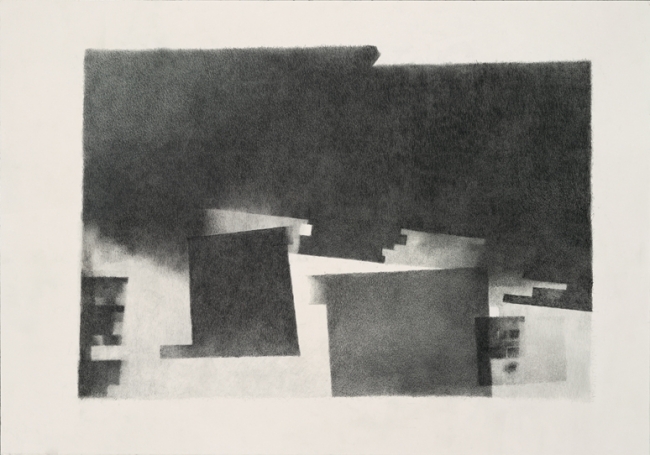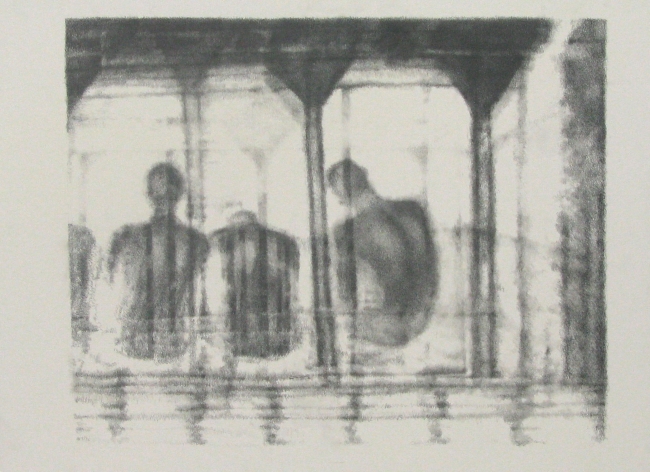| Zeichnungen | Biografie | Texte | Kontakt & Impressum |
| The Nature of
Pencil - Notes on Several Drawings |
| . . . .
. . With the help of
the most simple tools (a pencil) and a lustrously opaque material
(graphite). Faulhaber’s drawings after Talbot return the original
intention of the great English artist; to bring the „everyday world
close to us“ (Hegel) as something special, liberating a view of it from
all disturbing distractions. Talbot handed this world down to us. According to a seemingly necessary habit, it culminates in the unpredictable story of paper photography and is thus, without any contribution of its own, banned from the once existing everyday. Faulhaber’s pencil dusts and benumbs the perfect sheet. He dots it, and leads it to act like an organism to his touch, his laying on of his hands, his myriad points of acupuncture. The dark lustur of the graphite mists, fine as dust and thinly distributed, bring the space once hypnotized onto paper by photography - the floating, petrified bust of Patroclus in Talbot’s Lacock Abbey, the oval table, covered by what seems like a spirit’s hand - into a drawing of a dream. This costly, chemical preparation of captured and sieved light, an imprint of the midday sun on paper, is once again prepared by the artist - as drawing. The images Gerhard Faulhaber that lures from photography with the help of seemingly magical practices (the laying on of hands, acupuncture) are temporal in an extreme sense, just as an intimate immersion in Talbot’s shimmering twilight. Captured in an image: the chemical precipitates once distributes. By the effect of light and optics on the paper seem like something unchangeably coagulated: „photography“ as Sir John Herschel immediately recognized and need it. Gerhard Faulhaber has achieved the miracle of reanimating what seemed for ever inscribed, the preparation of light and shadow, regaining it tenderly in pencil and moving it towards a fragile ghostly state of aggregation. As if he had discovered Chladni’s magnetic trick of sound figures of iron dust for the art of drawing! |
| Hanss Zischler |
| (From catalog: Gerhard Faulhaber, ed. Zwinger Galerie, Alpheus Verlag, 2008) |

| Afterimages: On Drawing after Photography |
| Instead of thingly fixation, the
dissolution of contours. Instead of focusing the gaze, dispersion
across the visual field. Instead of capturing the moment, the extension
of time. Instead of expansive gesture, the signature absorbed in
micrological markings. Instead of expressing interiority, finding a
motif in already existing images. Instead of the individual picture,
the extension to a series. . . . . . . . Looking at the disegno tradition allows us to suddenly recognize the first and decisive characteristic of Faulhaber’s drawings based on photographs: the decision to reject the line as drawing’s foundational element. Instead of lines, these images emerge from a continuum of tonal gradation. The refusal is manifest on both poles of drawing, the act of drawing and the image produced. The spatially comprehensive gesture is abandoned, where a powerful line drawn across the paper tries to give external form to an inner image. Instead, the image results due to a process of gradual emergence: it does not develop from the moment, but into the moment, stretching it from within. . . . . . . . . . . . . . . . . . The fact that the visible emerges from shades of gray generates a non- sentimentality that neutralizes the pathos of the motifs, which could particularly germinate in the reflectographs of the illuminated trucks. The drawings evoke no atmosphere, have no mood. That they all the same possess an expressivity is because their neutrality does not result from apparative vision, as in the original models, but is individually endowed. In so doing, the characteristics of Faulhaber’s drawings mentioned at the beginning become an existential dictum. The dissolution of contours, dispersion across the visual field, the extension of time, the signature absorbed in micrological markings, finding motifs in already existing images, the extension to a series: all this makes a statement about what and how see, and how we can (not) contour ourselves vis-à-vis the world. |
| Michael Lüthy |
| (From catalog: Gerhard Faulhaber, ed.
Zwinger Galerie, Alpheus Verlag, 2008) |

| Light and Darkness |
| After
Images and Night Images by Gerhard Faulhaber X-ray: light that penetrates the body, rays that go beneath the surface. The new drawings …........ are equally figurative and shadowy. There is something mysterious about them. On the one hand, their silhouettes, captured in quite a realistic fashion, tell of people in a precisely described situation, sitting under a kind of baldachin with their backs to us, the beholders. For a moment, it almost seems as if we are looking at the back side of a Last Supper composition with these peaceful figures, some turned toward one another. At the same time, the scene is haunting and not precisely localizable, for the material of the bodies themselves do not seem fixed and opaque, but saturated with light: traces of the spinal cord and other bones can be seen and the skeleton glows through the veil of the living like a premonition of mortality. We think that these figures can be seen in a moment of transformation and transition, perhaps on a threshold from this world into the next. Indeed, the sense of crossing a threshold rests on a very concrete story. As the model for his drawings, Gerhard Faulhaber used photographs made at a real border, where people are actually X-rayed. The source: infrared pictures and x-ray photographs of trucks used for checks on the Mexico/US border to find illegal immigrants and arrest them. The moment in which the pictures emerge is at the same time the moment when the immigrants are discovered, and thus an existential moment, since this is the very moment when all hopes of a life in the US are burst. But they still know nothing of their discovery, as can be seen from the restfulness of their postures. But this political and geographical border is just one of the contexts that these images touch upon. Grid structures overlay the bodies, dotted lines flurry through them like snowflakes, arcs and pillars surround them. Even knowing that these shapes come from the tarpaulins on the trucks and the pallets the refugees are hiding behind, stronger than this knowledge are the associations these forms evoke of other spaces and structures. They are reminiscent of a city skyline or old arcades, and thus take on something of a journey through time and historical horizons. And because Gerhard Faulhaber repeats his motifs, in so doing shifting the framing and focusing differently on the scene, the play with these structural elements moves to the foreground. The space itself takes on something spectral and fleeting. . . . . . |
| Katrin Bettina Müller |
| (From catalog: Gerhard Faulhaber, ed.
Zwinger Galerie, Alpheus Verlag, 2008) |

| The Body in the
Drawing Arrangement |
| The
activity of drawing mediates between two corporealities: on the one
hand the corporeality of the person drawing, and the corporeality of
the person or thing being drawn. Drawing is thus considered the most
immediate of all the visual arts, for it makes this act of mediation
apparent. The “miracle” of art’s allowing an entire world to emerge on
a flat surface becomes visible in an especially elementary way, in that
ultimately a single line can suffice. At the same time, drawing is the
visual medium most directly marked by the gesture of the artist, in its
quickness, gravity, expressivity, or distanced nature. Herein lies the
essentially subjective moment of drawing, that always not only shows a
world, but within it also shows the relation of the drawer to the
things drawn: one of observation, wonder, or critique. In drawing, the
mediacy of art, that is, its capacity to mediate between subject and
world, proves particularly rooted in the body: it becomes a medium that
captures the trace of the drawing hand. At the same time, the body of
the drawer becomes a medium, an instrument for transferring the drawing
impulse to the sheet. |
| Michael Lüthy |
| (From catalog: Gerhard Faulhaber, ed.
Zwinger Galerie, Alpheus Verlag, 2008) |

